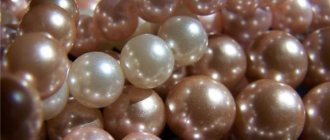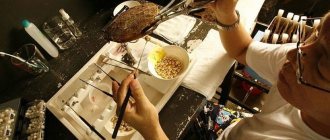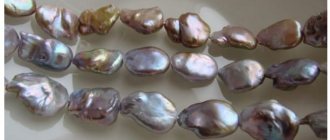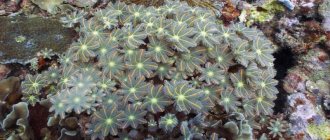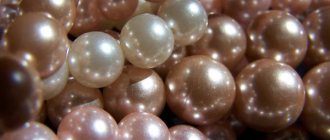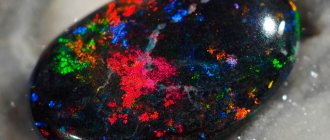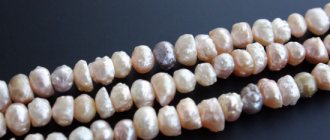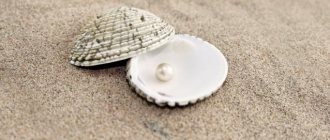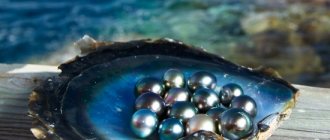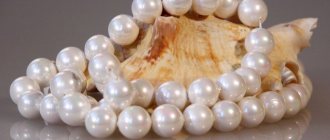| Stone type | Precious, semi-precious |
| Prevalence (Deposits) | Mexico, Panama, India, Tahiti, Sri Lanka, Japan, etc. |
| Varieties | Acoya, Baroque, Mabe, Mallorca, Oceanic, Freshwater, Tahiti, South Sea |
| Transparency | Translucent, opaque |
| Shine | Pearl |
| Mohs hardness scale | 3—4 |
| Chemical composition | CaCO3 |
| Color | White, blue, yellow, gold, pink, gray, black |
| Owner's color type | Spring, winter, autumn |
| Owner's temperament | Melancholic, Sanguine |
| Names | Andrey, Boris, Valentina, Galina, Eva, Evgeny, Evdokia, Inna, Irina, Claudia, Lilia, Margarita, Nadezhda, Oleg, Rosa, Sergey, Sofia, Elina, Yuliana |
| Zodiac sign | Libra, Cancer, Pisces |
| Date of Birth | from June 22 to July 22 from September 23 to October 23 from February 19 to March 20 |
| Chinese horoscope | Rabbit, horse, dog |
| Element | Water, Air |
| Planet | Neptune |
| Day of the week | Monday |
| Month | June, July, November, February |
| Season | Winter, summer, autumn |
| Numerology vibration | 2, 6, 7 |
| Chakra | Vishuddha, Sahasrara |
| What stones is it compatible with? | Aventurine, aquamarine, amethyst, turquoise, diamond, heliodor, heliotrope, garnet, emerald, moonstone, opal, rose quartz, ruby, chrysoprase, zircon, jasper |
| What stones is it not compatible with? | Beryl, malachite, sardonyx |
| Therapeutic effect (problems) | Blood pressure, vision, immunity, nervous disorders, memory and mental abilities |
| Therapeutic effect (on organs) | Organs of the gastrointestinal tract |
| Magic properties | Spiritual development, deception, strengthening relationships, black magic |
There are quite a lot of fans of jewelry with freshwater pearls.
Women love him for his refined, sophisticated appearance, which emphasizes their beauty and tenderness. A variety of jewelry is made from stones with a mother-of-pearl tint, for example, necklaces, rings, earrings with pearls, etc. Girls wear such sets with pleasure, but few of them think about what is special about river pearls, how they differ from sea pearls, what types of mineral exist. In addition, when choosing jewelry, you need to know how to distinguish an original freshwater stone from a fake.
What are freshwater pearls
Let's figure out what freshwater pearls are. Freshwater (river) is a mineral that is formed in a mollusk that lives in a river, lake, or even on a former rice plantation. A pearl is obtained when a foreign substance (sand, small fauna, etc.) gets inside the shell. The mollusk, trying to protect itself from damage, begins to secrete nacre, which covers the foreign object layer by layer. This is how any pearl is formed.
The peculiarity of river pearls is that they are formed in fresh water, and sea pearls - in salt water. For an ordinary person, they are practically no different - these are beads with a mother-of-pearl tint. But in fact there is a difference.
Freshwater pearls come in a variety of shapes and sizes. Standard bead dimensions are from 3 to 5 mm, but specimens of 2 and 8 mm are also available. It is extremely rare to obtain mother-of-pearl beads of 10 mm or more.
The most commonly used shell to create freshwater rocks is a common shell called Hyriopsis schegeli. Externally it is brown in color, and the inner walls are white and smooth.
This is interesting! In one freshwater mollusk you can find from 12 to 16 mother-of-pearl beads.
Natural pearls are mined in places where freshwater mollusks live in large numbers. But now, more and more often, river and sea stones are obtained from specially created farms. Externally, a natural pearl is practically no different from one grown with human participation.
In nature, no two pearls are identical; they differ in color and shape. Depending on the characteristics of development, the stone can have a round shape (rarely), irregular oval, ovoid, drop-shaped, etc.
You can distinguish freshwater pearls from sea pearls by the following criteria:
- Marine minerals have a deeper shine than freshwater ones. The latter are more often matte.
- Almost all types of river stones are oval in shape, while sea stones are round.
- Pearls from the sea are more expensive than pearls from the river. This is due to the fact that marine mollusks grow one stone at a time, while freshwater mollusks grow an average of 10 pieces.
- Freshwater pearls are more resistant to damage than sea pearls, as they have a thicker nacre shell.
- Freshwater minerals often have a milky tint, but growing a black or pink stone is almost impossible. The range of colors of sea beads is much wider.
Be sure to watch: How and where diamonds are mined
As you can see, there is a difference between sea and river pearls.
Areas of use
The main application is jewelry making. Craftsmen fell in love with sea pearls for their friendliness and beauty. There are many shades in nature, so it can be combined with almost any metal or gem.
Mother-of-pearl pearls are widely used among jewelers.
Fashion, which is closely interconnected with jewelry, also got along with pearls. In the Middle Ages, they decorated the clothes of noble people, decorated dishes and interior items with sea drops. Often among antique items you can find icons embroidered with mother-of-pearl beads.
Jewelry with pearls is not only an accessory, but also a talisman. The stone emits healing energy, so it will primarily be useful to those who are often sick. And for people in need of peace, it will help restore balance in life.
Today this tradition has not been forgotten, although such pleasure is not available to many. Ordinary people usually decorate holy images with beads or beads that imitate the appearance of real mother of pearl.
Healing and magical properties
Freshwater beads are believed to have many healing properties. The mysterious stone accelerates the recovery of many diseases. Beads made from mother-of-pearl beads strengthen the immune system and increase the body's resistance to viral and bacterial infections.
If you have problems with your kidneys, liver or stomach, it is recommended to buy earrings, a necklace or a bracelet made of freshwater pearls. Gems will help normalize the functionality of the nervous system, relieve depression, and make a person calmer and more confident.
There is a method of cleansing the body with river pearls. To do this, you need to lower the mother-of-pearl bead into a glass of water for 15 minutes, and then take it out and drink the liquid. You can also simply hold the pebble in your mouth for 10 - 15 minutes.
This is interesting! Freshwater pearls warn their owner about possible diseases. If a person is sick, the stone becomes dull, which is a good reason to visit a doctor.
The freshwater mineral was used in ancient times as a talisman and a means to prolong youth. Mother-of-pearl beads help improve the situation in the family, protect the house from thieves, evil and deceitful people, unsuccessful transactions and rash actions. The stone helps you quickly find a common language with new people and make good friends.
Freshwater pearls are best avoided by vain, envious, and greedy people.
The freshwater mineral absorbs the bad energy of its owner, taking away his illnesses and problems. That is why it is highly not recommended to make it a family heirloom, otherwise you can bring on various troubles.
Interesting Facts
Despite prejudices and superstitions, many brides choose pearls as decoration.
Pearls are a mysterious and mysterious stone. There are many legends, signs, and prejudices associated with him:
- Our Slavic ancestors believed that this was a good wedding gift. The groom gave pearl jewelry to his beloved so that their life together would be happy.
- In some European countries, there is a tradition of tying newlyweds with mother-of-pearl beads right at the wedding. There is a sign associated with it that helps to understand whether the newlyweds will be together. A broken thread promised tears and a break in relationships.
- Nowadays people believe that wearing pearls to a wedding is a bad omen. Supposedly this leads to tears. Apparently, this superstition was facilitated by the fact that pearls were previously called “tears of the sea.”
- Women love jewelry and often receive pearls for their birthdays. Experts are still arguing about this. Some believe that it is not worth giving it for a birthday, so as not to doom your loved one to misfortune, while others say that a better symbol of happiness cannot be found.
- The stone is often recommended to be worn in pairs. It helps maintain harmony in relationships, smooth out misunderstandings, and dispel negative energy in the home. But there is a danger here - the talisman can reduce sexual attraction to a partner, so it is better not to abuse it.
Varieties of freshwater pearls
Depending on the method of formation, the following types of freshwater pearls are distinguished:
- Natural. This is a method of stone formation without human intervention. This type of mineral is formed spontaneously, in places where freshwater mollusks live. Such mother-of-pearl beads are considered the rarest and most expensive. This method is the most expensive and time consuming.
- Cultured. This is a method of growing river pearls, during which a special particle is implanted into the shell, overgrown with nacre. This is how the stone is formed over several years.
Currently, about 99% of freshwater pearls on the market are cultured.
Some people consider it artificial, but this is not the case, it is a natural material that is also grown in pearl mussels (the mollusk in which pearls are formed). As mentioned, freshwater pearls vary in shape, color and size.
SEA AND FRESHWATER PEARLS⠀⠀Shine The naked eye can see that shelf pearls have a bright mother-of-pearl...
Published by Jewelry from the brand Olga Shatrova Wednesday, April 25, 2022
Shapes and colors
“Culture” (cultured) pearls rarely have a regular spherical shape. As a rule, mother-of-pearl beads are found in the shape of a flat button, oval, pear, drop, baroque (irregular shape).
People who grow freshwater pearls have little influence on this process, so they cannot know exactly what the final result will be.
The color range of freshwater stones is not as rich as that of sea stones. The final color depends on the type of oyster, where it lives, the chemical composition of the water, or the compounds used during cultivation.
Most often, freshwater pearls of a milky hue go on sale; it is impossible to obtain a perfectly white stone. In addition, there are beads of gray, beige, brown or greenish tint. Despite the limited color range, freshwater pearls look quite attractive.
Dimensions
Most often, freshwater pearls are medium in size, this is especially noticeable when comparing them with sea stones. The dimensions of a particular specimen depend on the age of the pearl oyster.
Depending on the size, the following types of freshwater pearls are distinguished:
- Varietal. The diameter of such mother-of-pearl beads ranges from 5 to 10 mm. This type of stone is considered the most expensive. The high cost is due to the fact that it is quite difficult to grow such large specimens in a freshwater body. As a rule, such pearls are used to create jewelry.
- Beads. The diameter of this variety of beads ranges from 3 to 5 mm. Freshwater pearls reach this size after 1.5 – 2 years. Ready-made beads are used to create jewelry.
- Pearl dust. The diameter of such pearls barely reaches 2 – 3 mm. Mother of pearl beads are used to decorate designer clothes.
Be sure to check out: How to clean a diamond at home
Most often, river “beads” are found on sale.
This is interesting! In 1.5 years, the pearl inside the mollusk reaches 3 mm. After 3 years, its diameter already exceeds 5–6 mm. If you wait another 4 years, the size of the stone may exceed 7 - 10 mm.
Mining freshwater pearls
Freshwater pearls are mined in China, Russia, Germany, and the USA. About 99% of pearls that go on sale are cultured. The leader in the production of mother-of-pearl beads is China.
The place where pearls are grown can be not only a river or lake, but also rice plantations flooded with water that are no longer used for their intended purpose. These fields have a suitable microclimate for the rapid reproduction and cultivation of mother-of-pearl beads.
Freshwater pearls do not have a nucleus, as they are created using a nuclear-free method. To do this, foreign tissue is introduced into the skin fold of the mollusk’s body, which begins to become covered with balls of mother-of-pearl. The layer of mother-of-pearl in freshwater stones is thicker than in sea stones.
The nuclear-free method allows you to insert several implants into the shell at once to grow several pearls. About 12–16 beads can form simultaneously in one mollusk. During growth, mother-of-pearl beads must be periodically turned over so that their shape is as close as possible to the spherical one, which is considered the standard.
This is interesting! There is another technology for creating freshwater pearls, which is called “Mabe pearls”. To implement it, a plastic ball is inserted into the sink, which is gradually covered with mother-of-pearl. Then a hole is drilled in the ball, and the empty space is filled with epoxy resin. Such a core grows well, and the stones turn out perfectly smooth.
River pearls are not currently mined in a natural way, as this is destructive to nature and costly in material terms. It is much more profitable to create a farm on which, in any case, there will be freshwater pearls.
Do you like freshwater pearls?
Very Not particularly
Criteria influencing the assessment
There are several characteristics that allow you to evaluate the quality and affect the cost of freshwater pearls:
- Gloss intensity is one of the most important criteria. The glow should be deep. To evaluate this parameter, you need to carefully examine the pearl under a light source. The best specimens are those in which the boundary between the brightest and darkest areas is clearly defined. Such stones are more expensive.
- Thickness of the mother-of-pearl layer. The longer the pearl is in the mollusk, the thicker its nacre shell. A high-quality bead can retain its beauty for several hundred years. A high-quality specimen can be identified by the following characteristics: the stone is cool and weighty, layers of mother-of-pearl are visible in the drilled hole, the reflection is uniform.
- Surface quality. Natural mother-of-pearl beads may not be perfect, but the fewer defects on its surface, the better quality it is.
- Pearl shape. The most expensive stone is considered to be a perfectly round stone, followed by oval or teardrop-shaped stones. Baroque stones that have an irregular shape have the lowest price.
- Size. The diameter of freshwater pearls ranges from 3 to 11 mm. The larger the circumference of a pea, the more expensive it is.
- Color. The white shade of pearls is considered classic. In addition, beads in cream, white-pink, and light brown shades can be found on sale. You need to evaluate color saturation under a lamp on a light surface.
- The similarity of pearls in decoration. If high-quality pearls were used to create the product, then the degree of their coincidence should be high.
These are the main parameters that will help you choose high-quality freshwater pearls.
How to distinguish from a fake
Nowadays, the jewelry market increasingly comes across a fake, which is a ball of plastic or glass covered with a layer of artificial mother-of-pearl. As a rule, such specimens are used to make cheap jewelry, but sometimes unscrupulous manufacturers pass them off as natural river pearls. The following techniques will help you distinguish fakes from the original:
- Rub the stones against each other: natural products will cling and squeak, while artificial ones will slide.
- Just hold the beads in your hand, they have a noticeable weight and are cool to the touch, and the counterfeit is almost weightless.
- Look at the holes in the beads: the original has uneven edges, layers of mother-of-pearl can be seen, but the fake has perfectly smooth walls, and the bead is empty inside.
- Throw a stone onto a flat surface: natural stone will bounce, but synthetic stone will roll.
These are the main differences between real freshwater pearls and fake ones.
In addition, you should remember that natural mother-of-pearl beads cannot be cheap.
Who is suitable according to their zodiac sign?
There is no need to be afraid of confusion with astrological compatibility. The stone was discovered a long time ago, and astrology did not appear today. This means that experts had a lot of time to study the influence of the stone on the zodiac signs.
Who is it suitable for:
- Cancer and Pisces. Pearls and these zodiac signs belong to the same element - water. But don't be fooled. This harmonious union can also cause harm. Too frequent contact with the talisman will turn Cancers and Pisces into hypersensitive individuals.
- Taurus . But with this sign it’s the other way around. The stone will quickly pacify the restive temperament of the stubborn Taurus and teach him to get along with loved ones.
- Aquarius . This sign will also receive its portion of peace from the sea amulet.
There are also signs for whom the stone is not suitable at all. The first candidate for incompatibility is Leo . All because the elements of fire and the elements of water are at enmity with each other, oppressing each other. Therefore, the king of beasts cannot expect any benefit from the water talisman. If Leo begins to wear this stone often, his usual successes in his career will quickly turn into failures. for Sagittarius and Aries for the same reason. Gemini and Capricorn not to buy items with pearls .
Main conclusions
Freshwater pearls are grown on special farms. Externally, freshwater beads are practically no different from sea beads, but they can be distinguished by their shine, shape, color, durability and price.
The leader in stone production is China. Most river pearls are oval or pear-shaped. And their color range is limited: from beige to light brown. The most common size of the mineral ranges from 3 to 5 mm.
To distinguish a fake from an original, you need to pay attention to the weight, surface and edges of the holes of the products. The magical and healing properties of river pearls are impressive, their appearance brings aesthetic pleasure, and the price is much cheaper than sea pearls.
Where is the best place to check?
It is not difficult to recognize the nature of pearls. But how can you check it for sure? It is more convenient to do this in a jewelry salon, where everything is clearly visible and there is no need to rush. You can calmly examine the stone, touch it, and evaluate the texture of the mother-of-pearl.
Tags on jewelry and accompanying documents will help. It's easier to appreciate the differences when you have both views in front of your eyes at once. The assortment of the salon allows this.
Today, pearls of different origins and prices are available. The sea mineral is expensive, but aristocratic.
It is possible to find river specimens grown using the latest technologies. Their aesthetic appeal is not inferior to those obtained from the sea, they are more durable to wear, but more pleasant in price. Therefore, you should proceed from your own financial capabilities, preferences, and purpose of purchase.
